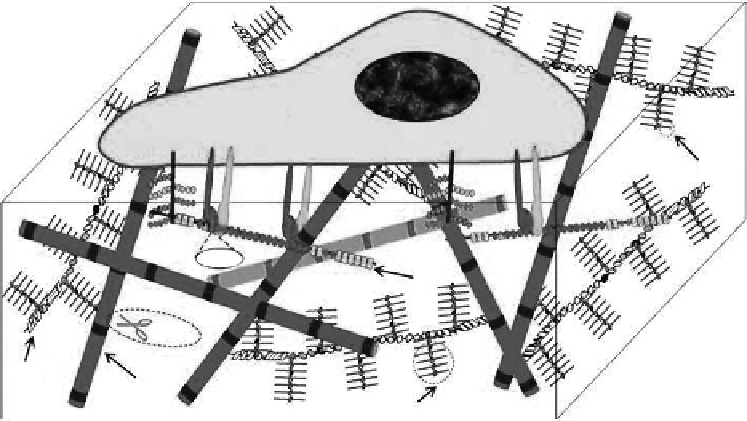Biomedical Engineering Reference
In-Depth Information
Cell
Integrin
Syndecan
GAG
RGD
FN
MMP
HA
Collagen
PG
Figure 9.8
Model of the complex 3D structure of ECM and cell-ECM interactions. (From Zhu, J. M. 2010.
Biomaterials
31:4639-4656. With permission.)
a very important parameter to influence cell behaviors. For example, the concentration of
HA is a more important factor to affect the behavior of cells in addition to HA itself. Only
the concentrations of HA in a certain range (0.01-0.1%) in chitosan-gelatin-HA composite
film could enhance cell adhesion, migration, and proliferation. However, when the concen-
tration of HA was above 0.1%, it could inhibit cell adhesion, migration, and proliferation
(
cf.
Figure 9.9)
[49]. The fibroblasts seeded on 0.01% HA membrane grew and proliferated
with an almost extended shape and most of them were fusiform. However, fibroblasts
seeded on 1% HA membrane arrayed irregularly and their shape had changed a lot. The
chitosan-chondroitin sulfate (90/10 w/w) film showed excellent cytocompatibility for
fibroblasts [50]. Moreover, protein adsorption is a determining step for cell adhesion and
will further control cell morphology, as well as their proliferation capacity the type of
adsorbed proteins and their orientation are related to the surface properties, especially
to surface energy. Neither very low polar components nor very high ones were suitable
for correct cell attachment/morphology. The composites of chitosan-based biomaterials
are the main factor influencing surface energy. For example, plasma-treated and sulfonic
acid-grafted chitosan films presented better cell viability and proliferation than untreated
and acrylic acid-grafted samples [51]. Proliferation of cells seeded on more hydrophilic
N
-butyl chitosan surface was higher than that on
N
-cetyl chitosan surface [52].
9.3.3 effect of Matrix Stiffness
Most cell types studied so far spread more, adhere better, and appear to survive better on
stiffer matrices, and some cannot grow on very soft (<50 Pa) surfaces. Other cell types,
such as neutrophils, appear not to respond to substrate stiffness, at least over the range of
3-50,000 Pa that can be accessed experimentally. Still other cell types, such as neurons,
extend processes more avidly and appear to survive better on soft materials [53]. Matrix
stiffness can regulate the degree of cell-matrix adhesion, migration, growth, and viability,
as well as resistance to apoptosis [54]. Cells on stiff matrices are proliferative and fibrogenic,

Search WWH ::

Custom Search